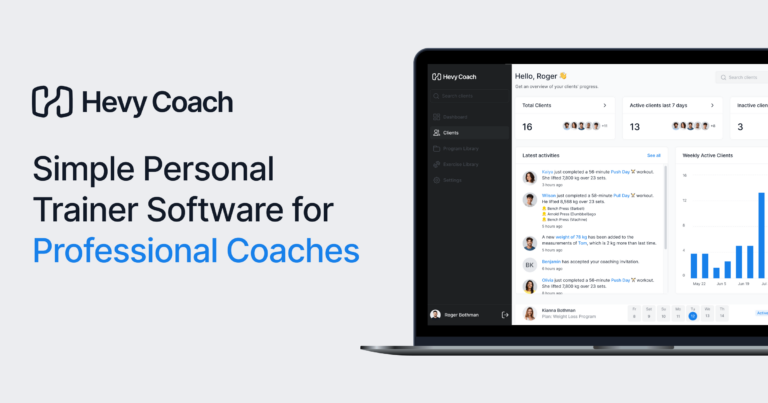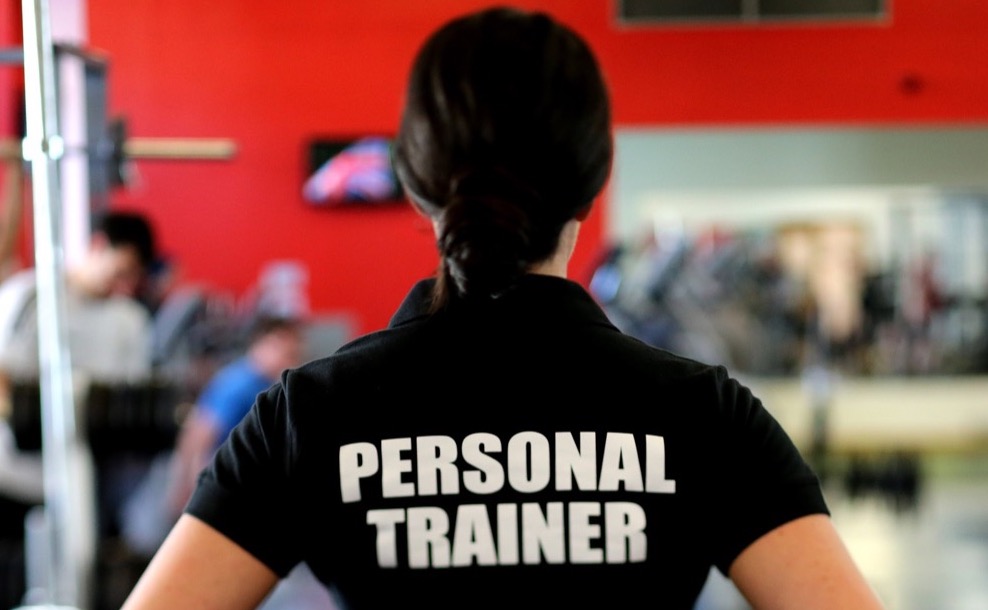Fitness Business Ideas for 2024: A Quick Look
Simple and effective fitness business ideas for 2024:
- Become a personal trainer to gain experience and get your name out there.
- Sell workout plans online to earn recurring and passive income while helping people reach their training goals.
- Open a small gym to coach people how you want (groups, semi-private, private, etc.) and enjoy higher profit margins.
1. Become an Online Fitness Coach
Online fitness coaching has become a popular career path for many fitness professionals because it offers flexibility and access to a large client base.
Coaches can earn good money, enjoy flexible hours, have free time for side projects, hobbies, and other endeavors, and work with people worldwide.
The approach is also popular because coaches can pick from multiple options:
- 1:1 coaching, where communications occur primarily through email and clients pay a monthly fee
- Virtual sessions, where coaches guide clients through workouts and typically charge per session
- Workout plans, where you create and sell 4, 8, or 12+ week programs, and people follow them (more on that below)
To be successful, it’s essential to determine who your ideal client is. Don’t be afraid to niche down and be highly specific on who you can help.
Instead of trying to be everyone’s coach and struggling to differentiate yourself, make yourself as helpful as possible for a small group of people.
Also, create workout templates to streamline the process of generating training plans for new and existing clients. Instead of building a program from scratch, you can take a template that best suits a specific client and adapt it to them.
A coaching software like Hevy Coach can also streamline the process. With it, you can create training programs, assign them to your clients, monitor their progress, answer questions, and make changes when necessary.
Your clients would gain access to their assigned workouts inside the Hevy app, making the experience smooth and easy to track.
For more tips on online fitness training, read our article here.

Try Hevy Coach
Intuitive personal trainer software, with a world class experience for your clients.
30 day free trial, no credit card required
2. Sell Workout Plans Online
Selling workout plans online can be seen as a form of online coaching. After all, you create programs for people, and their job is to follow your guidance as outlined.
That said, the approach is different from online coaching because clients have far more independence and must figure out how to solve specific problems on their own.
Pre-made plans can be beneficial for clients with experience in working out, autoregulating when necessary, and tracking their nutrition. I don’t recommend selling them to beginners who have yet to learn the nuances of structured resistance training.
One benefit of selling workout plans is that you can enjoy more passive revenue without doing that much work.
Similar to a trainer using workout templates, you can create several workout plans based on the following:
- Experience: beginner, intermediate, and advanced
- Goals: build muscle, lose fat, etc
- Free time: for example, low-frequency plans for busier individuals and higher-frequency ones for people with more free time
From there, adjust based on individual needs.
To earn more, you can experiment with tier pricing. The first tier could be a basic workout plan at a lower price.
A mid-tier offer could include some extras (e.g., chat support, technique review, etc.) at a higher price.
Finally, a premium tear could include all these things, plus nutritional coaching, accountability, progress tracking, ongoing adjustments to the training plan, etc.
Figuring out how to price your workout plans can be difficult, so feel free to read our guide on determining your rates.
3. Become a Personal Trainer
Becoming a personal trainer might not seem like the best career path, but there are plenty of benefits, whether you want to stick to that profession for a long time or branch out to other areas later.
At its core, personal training is a fantastic way to get started in the fitness industry because:
- It’s not that difficult to get certified and land a job
- You get to help people, which is always nice
- You learn about the problems people are facing
- You gain expertise and unique insight that’s always going to be valuable
Plus, you can earn good money. According to our research, personal trainer salaries for 2024 are:
- $53,540 in the US
- £39,888 in the UK
- $58,060 in Canada
- $65,000 to $82,000+ in Australia (based on different reports)

Read our full report on the topic here.
Additionally, personal training can serve as a stepping stone on your journey of professional development. Coaching people provides unique insight and helps you learn more about people: their goals, expectations, struggles, limiting beliefs, and more.
That insight is valuable because it can later help you create better products, craft more enticing marketing copy, and even coach people online if you prefer.
For example, by spending hundreds or thousands of hours teaching people how to do various exercises, you begin to spot patterns, such as common errors and compensatory movement patterns people are bound to develop if left unsupervised.
A popular example is how the back might round more when people attempt to deadlift more weight than they can handle. Of course, that’s an obvious one, but there are far subtler ones for almost all the exercises people do at the gym.
If you later decide to create YouTube videos or video shorts (e.g., instructions on how to do exercises) to build an audience, that unique insight can be of tremendous help.
Almost all successful content creators have a background in coaching, and many continue to work with clients even after building a large following online because that’s a unique learning experience that further grows their expertise.
4. Help People Eat Better with Nutritional Coaching
It’s no secret that proper nutrition is essential for fitness success. You could provide the best training guidance that accounts for even the most minor details in your client’s life, but they will fail to make noticeable progress if they don’t pay attention to what they eat.
In a way, nutrition is far more challenging to control than training because we must be disciplined and mindful all day, every day. In contrast, most people can optimize their training and do everything ‘right’ in that area with less effort and discipline. After all, a workout can be as short as 30 to 45 minutes but still provide the necessary stimulus to drive results.
With that in mind, perhaps instead of becoming a trainer, you could focus on nutrition––the area where people often struggle the most. Be the guide people need and keep your clients accountable to help them improve their health, fitness, and relationship with food.
For example, help clients develop a unique approach that suits their goals, eating preferences, schedule, etc. You could start by creating meal plans for clients and explaining the reasoning behind your choices. As time passes, you can encourage your clients to take charge of their nutrition and apply what you’ve taught them.
Another option is teaching clients to track their calories and macronutrients using tools like MyFitnessPal and a simple kitchen scale. That approach is far more flexible because your clients will have greater freedom to pick what foods to eat so long as they cover their daily needs.
Also, teach your clients fundamentals such as portion control, mindful eating, food selection, and satiety.
Here are a few quick tips if you decide to go down that route:
- Earn the appropriate certification (for example, this one by NASM) to build credibility and set yourself apart
- Stay up-to-date with the latest findings in nutrition, discuss them with clients who show interest, and don’t be afraid to change your approach when presented with new information
- Listen to your clients to understand their nutritional preferences and goals
- Talk about the importance of balance and flexibility in a sustainable dietary plan; discuss the drawbacks of rigid dieting with your clients
5. Open a Small Gym or Studio
Owning a brick-and-mortar business can be immensely satisfying. When done right, it can also be highly profitable and scalable. You could start with a single, small location and expand to a second location and a third down the line.
Of course, a physical business, such as a small gym or fitness studio, is more difficult to scale than an online fitness business, but it’s still possible.
More importantly, opening a gym or studio can be the next step for personal trainers. As a beginner, you can start by working for someone else to gain access to an existing clientele, learn from an expert with more experience, and see how such a business operates.
Then, as you gain experience, build up a list of clients, and hopefully save up some money to invest, you can set up your personal training business. This ‘running start’ can make the transition smoother and help you go through the early months of uncertainty.
Like with personal training, having a small gym or studio and coaching clients can be a great way to gain experience and insight that could help you establish more successful fitness businesses down the line.
A notable difference is that you would be responsible for everything:
- Paying rent
- Getting the appropriate insurance
- Buying and maintaining gym equipment
- Ensuring safety and keeping the facility lean
- Business planning and marketing
- Managing the payroll for your employees
- Handling tax obligations
It can be stressful, but you would also earn more, decide how to run your business and make decisions for its future.
Being an owner also gives you more freedom to try different things and establish multiple income streams. You can work with clients one-on-one, host group sessions (or offer semi-private personal training), and set up fun fitness challenges.
Are you looking to branch out into online coaching? You could host virtual fitness classes, where you walk your clients through warm-ups, workouts, and cooldowns.

Try Hevy Coach
Intuitive personal trainer software, with a world class experience for your clients.
30 day free trial, no credit card required
6. Try Hybrid Personal Training
Hybrid personal training is another potentially profitable business idea for 2024. The premise is simple:
Coach your clients online and meet up occasionally for an in-person session to review their form, see how hard they are working out, examine their set-up for various movements, and more.
In essence, the goal of in-person sessions is to closely examine things you can’t see when coaching them online.
However, for this to work, you need clients who:
- Live close enough to meet you at a specific gym once in a while
- Prefer to be coached online instead of in person
- Are experienced enough to carry out their training without supervision
For example, if one of your online clients lives 1,000 miles away, the hybrid approach won’t work for obvious reasons. Similarly, if the client is not that experienced, it would be better to coach them in person for the time being.
Also, for the approach to work, you need to be already coaching people in person and pitch them the idea of hybrid personal training.
The primary benefit of the approach for your clients is they have more freedom to train whenever and wherever it suits them. Instead of trying to fit coaching sessions into their busy mornings or afternoons, they can work out when they can––be it in the early morning or late at night.
However, while they have more freedom, there is still an element of accountability because the next in-person session is always around the corner.
As such, they know they have to stay consistent and work hard to show you how much progress they’ve made since the last time you saw them.
7. Offer Personal Training from Home
Let’s say you don’t want to work for someone else, but you also can’t afford to open a small gym or studio. Is there anything you can do? Fortunately, yes. The solution in such a situation is providing at-home personal training services.
Though still challenging to pull off, this approach gives personal trainers more freedom and allows them to establish a practice without investing as much money initially.
The two options are:
- Coach people at your home
- Visit clients at their homes
Both options come with benefits and drawbacks.
First, there’s the option to coach people at your home. Some of the benefits include:
- It’s your territory
- The startup cost is low
- You don’t have to commute
- You can set up a good home gym and provide clients with everything they need
- There’s an opportunity to transition to online coaching
However, there are also a few drawbacks:
- It could feel like an invasion of privacy
- Distractions could affect workout sessions
- You might not have enough space for workouts
- Neighbors might complain of noises
- The growth potential is limited
- You might not appear as professional
Visiting clients at their homes is also an option with benefits and drawbacks. Let’s first look at some pros:
- Your work locations change all the time
- You get a chance to form deeper connections with clients
- You can grow and make your fitness business profitable
- Avoid gym memberships and fees
Now let’s look at some cons:
- You might need a larger vehicle to drive around fitness equipment
- Too much commuting can be exhausting
- There is a risk of being late for some appointments due to traffic
- Carrying around equipment can be challenging
To get started, earn a personal training certification to expand your expertise and knowledge, as well as become more credible.
From there, decide how you want to conduct business (at your home, clients’ homes, or both), consider all the possible expenses (purchasing equipment, getting insurance, having the appropriate vehicle for house calls, etc.), and determine your rates.
If you decide to work from your home, check local laws and regulations to make sure that you can conduct this type of business legally.
Also, set specific rules for clients to make sure you’re on the same page. Go over things like:
- The importance of you and your clients being on time
- What happens if a client doesn’t show up for a session
- What items clients must bring if they are coming to your home
- How will you take payments
- What areas of your home clients can access
8. Go Outside: Combine Fitness and Nature

While not as popular, outdoor classes are another option to consider, especially if you live in a country or state where the winters are mild and there isn’t as much rain throughout the year.
There is no better feeling than training outside, soaking up sunlight, and enjoying a refreshing breeze. Outdoor workouts can be a great change in scenery and offer a unique way to combine nature and fitness.
Whether you want to offer yoga classes at the beach or run a bootcamp in a park, there are plenty of opportunities to get people outside and show them how fun outdoor physical activity can be.
One key benefit of outdoor training over classic gym exercise is the natural surroundings’ positive impact on mental health. Research suggests outdoor time can reduce stress, boost mood, and promote well-being.
Combining these effects with the endorphin rush that is sure to follow a good workout can create an overwhelmingly positive experience for your clients.
Outdoor workouts can also offer some unique challenges people aren’t used to. Even something as simple as jogging can be infinitely more engaging outside than on a treadmill.
For example, changes in the terrain and incline people run on can make for more engaging and unpredictable workouts that promote balance and agility. Plus, small challenges can keep the mind engaged, forcing your clients to be more involved in the activities and have more fun.
9. Build a Presence Online
Building a presence online is not exactly a fitness business idea but rather something every fitness professional should consider.
A large and engaged following online provides organic exposure for your brand, helps you build a reputation in the health and fitness industry, and leads to new business opportunities.
First, having a large following online makes you more credible. Even if you only want to coach people in person, having an established fanbase online instantly sets you apart from many of your competitors, making you the obvious choice.
Second, an online presence can present new revenue sources. Examples include:
- Coaching people online
- Selling digital products (courses, eBooks, workout plans, etc.)
- Promoting products and earning affiliate income
- Using sponsored posts, similar to how influencers promote products
Third, having an established following makes it easier to gather feedback from people and learn what problems your audience faces.
Commons on social media posts, surveys, emails, and direct messages can be treasure troves of valuable insight other companies pay thousands of dollars to get.
For instance, if you build a large email list, you can occasionally send surveys to people and ask them to share a bit about their struggles and what holds them back from reaching their goals.
In addition to boosting engagement, doing so provides the insight you need to create products people want, offer services your audience needs, and write sales copy that converts.
By showing people you understand their struggles, they are more likely to pick you over thousands of other fitness professionals.
Plus, instead of using ads to promote your business online, you can create content (click here for 16 ideas) to grow your audience, influence, and reach.
With that said, building an online presence doesn’t happen overnight. It takes months, even years, of consistently publishing quality content and engaging with people to see noticeable results.
This is particularly true in the case of blogging, as content often takes time to rank on Google, and link building is a long game. Publishing content on social media could bring quicker results, as there is an element of virality there, but it still requires good timing and some luck.
10. Start a Social Media Business
Another lucrative fitness business idea is to start a social media brand. In other words, become an influencer.
Some benefits of the approach include:
- Low start-up costs: creating social media accounts is free. You can create and publish the content yourself to further avoid expenses.
- Large reach: the number of people you can reach, especially in the beginning, won’t be that high. However, as someone with a social media account, the sky is the limit because you can potentially reach millions of users with relevant interests.
- Targeted advertising: should you decide to invest in paid ads, some social media platforms offer more advanced targeting options, allowing your ads to reach people more likely to convert.
- Instant feedback: social media is designed to promote engagement, which is highly beneficial for content creators.
Once you gain some followers, you will receive almost instant feedback on new content, which could spark discussions, provide insight, and give you ideas for future posts. - Multiple ways to earn money: as discussed in the previous point, building an online presence creates new opportunities to make money, including by selling digital products, promoting other people’s products (sponsored posts and affiliate marketing), and coaching people online.

That said, a social media business comes with some drawbacks. Let’s look at some:
- Getting started is hard: while cheap, getting your business off the ground can be tough because it takes time to gain momentum. People won’t immediately know who you are and readily follow you.
- You’re exposed to criticism: critics can sometimes provide valuable feedback that helps you build a successful business. However, it’s not always easy to take it on the chin and move on.
- You’re at the mercy of the platforms: you can work hard for years to build a presence, only to have your account suspended or reach hindered by new updates. The problem is that none of that is under your control, but such changes can affect your bottom line.
- Requires constant output: coming up with interesting content ideas all the time can be exhausting and could lead to burnout. The problem is that you can’t take your foot off the gas pedal because that can affect your profile’s visibility, reach, and overall engagement.
11. Consider Who Your Ideal Client Is and Specialize
To finish the list, we have a tip for coming up with more successful business ideas.
What’s the first thing that comes to mind when brainstorming fitness business ideas? Probably something along the lines of, “Okay, how can I help people on their fitness journey and earn a good living?”
That’s normal. But have you ever actually considered who you want to help? The answer might seem obvious––”Duh, I want to help people get fit.” But the more you think about it, the more you realize how many possible paths exist.
Do you want to help high school and college-aged people get fit for a sport? Or perhaps you want to help older individuals regain their strength and mobility to lead more fulfilling lives? Are you a skilled strength coach looking to help powerlifters with the big three lifts?
Maybe you’ve been overweight before and are now looking to share what you’ve learned and show empathy and patience while helping people lose weight for good.
Deciding who you want to help can be difficult, but it pays off in the long run. Doing so allows you to specialize in a specific niche, build a name for yourself, and hone your marketing message based on the goals and roadblocks of your ideal client.
Take Karl Bratland as an example. He specializes in helping dads get fit. While it might seem like he is unnecessarily limiting his reach, that is far from the truth. Being the guy or gal for a specific group of people makes it easier to gain relevant followers and enjoy better business opportunities.
Conclusion
Whether you lean toward a physical fitness business online or in the real world, the above are some fantastic ideas to consider.
As you can see, each has its unique benefits and drawbacks, so it’s up to you to think about the type of work you’d like to do and go down a path that makes it possible.
Online businesses are generally cheaper and less risky to start, whereas brick-and-mortar ones require a larger upfront investment.
That said, both options can work in the long run, so long as you’re aware of the risks and put the customer experience first.
One way in which you can boost the experience for your clients is by using a platform like Hevy Coach. With it, you can create training plans, assign them to clients, track their progress from the dashboard, answer questions, and make quick changes when necessary.
Your clients would gain access to their training plans through the Hevy app, and they could easily log each session.
FAQs
1. Is owning a gym a good idea?
Owning a gym can be a great idea if there is demand for one in your area, if you’re passionate about fitness, and if you have good management skills. However, it also requires a significant upfront investment, and it might take some time to turn a profit.
2. What is a low-risk fitness business to start?
A low-risk fitness business is typically one you start online. Becoming an online coach, selling workout plans, providing virtual classes, and starting a social media fitness business are some low-cost ideas.
3. What kind of a fitness business should I start?
You should start a business that fits your long-term goals, strengths, skillset, preferences, and risk tolerance. It’s best to do your independent research to understand the market and what people are looking for.




